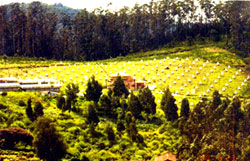 Cosmic
rays are charged particles coming from outisde the earth's atmosphere
and its energy varies from around 10^6 degree e V to around 1021e
V. Cosmic Rays were discovered by victor by gictor hess, an Austrian
Scientist in 1912 and he was awarded the noble prize in physics
for this discovery, twenty four years later. Cosmic rays from
a very important constituent not only of our own galaxy but of
the entire universe. Cosmic rays are charged particles coming
from outisde the earth's atmosphere and its energy varies from
around 10^6 degree e V to around 10^21 e V. Cosmic Rays were discovered
by victor by gictor hess, an Austrian Scientist in 1912 and he
was awarded the noble prize in physics for this discovery, twenty
four years later. Cosmic rays from a very important constituent
not only of our own galaxy but of the entire universe.
Cosmic
rays are charged particles coming from outisde the earth's atmosphere
and its energy varies from around 10^6 degree e V to around 1021e
V. Cosmic Rays were discovered by victor by gictor hess, an Austrian
Scientist in 1912 and he was awarded the noble prize in physics
for this discovery, twenty four years later. Cosmic rays from
a very important constituent not only of our own galaxy but of
the entire universe. Cosmic rays are charged particles coming
from outisde the earth's atmosphere and its energy varies from
around 10^6 degree e V to around 10^21 e V. Cosmic Rays were discovered
by victor by gictor hess, an Austrian Scientist in 1912 and he
was awarded the noble prize in physics for this discovery, twenty
four years later. Cosmic rays from a very important constituent
not only of our own galaxy but of the entire universe.
They
play vital role in the dynamics and evolution of the galaxy.
So it is important to study different aspects (like source,energy,composition
at different energy range etc) of cosmic rays. Low eneryg cosmic
rays are studied by sending a detector in space in balloon rockets
or satellities since they get absorbed in their earth's atmosphere.
High energy cosmic ray interact with the oxygen and nitrogen
nuclei in the atmosphere and produce a large number of secondary
particles. When the energy of the cosmic rays incident on the
top of the atmosphere is more than 10^13 e V, the secondary
particles reach the earth's surface as a shower of particles
and is known as Extensive Air Shower (EAS). Detecting these
secondary particles does studies of high energy cosmic rays
are done by detecting these secondary practicles. In the early
fifties, not much was known about the EAS. So mountains altitudes
were most suitable for experiments in cosmic rays, because of
their larger intensity at higher levels. Operation time will
be small at balloon altitudes and the intensity will be low
at sea level.
Keeping
this experiment going, a new large air shower experiments is
set up at the campus of the Radio Astronomy Center in muthorai
village of the Nilgiris. 3840 proporational counters (area of
crosssection 10 * 10 cms and length 6m each are already installed,
under large concrete shielding, for the detection of mu mesons.
257 plastic scintillators of area one square meter each are
operational. This will be expanded to 721 detectors shortly.
Data collection startedin 1998, and is still going on along
with the work for expansion.
Let
us summarise the out come of the work done here. Eight members
have got their Ph.D degree and two others have done their M.Sc
by thesis.Ninety papers are published in International Journals,
and Ooty is well known, all over the world, among the scientific
community.